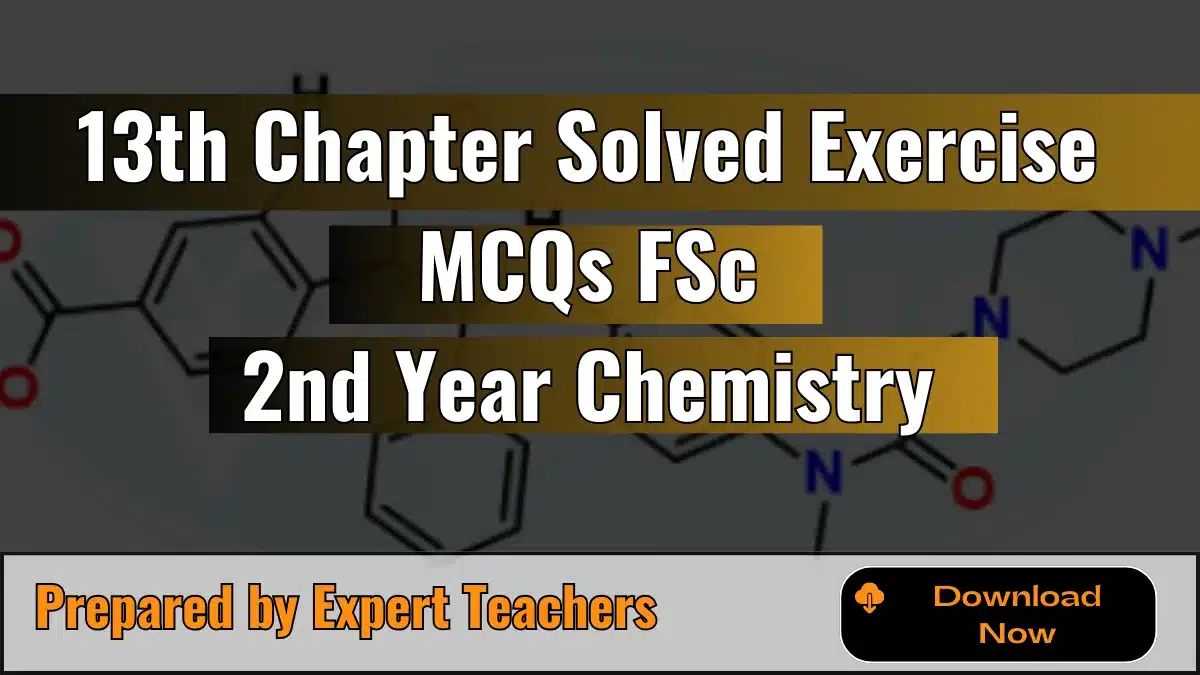Fourth Chapter Solved Exercise MCQs Of FSC Second Year Chemistry
The 4th Chapter Solved Exercise MCQs of FSC 2nd-year Chemistry provides a complete set of solved multiple-choice questions (MCQs). Each MCQ comes with a brief explanation to help you understand the correct answer. These solutions are designed to support students in preparing for their exams, making complex concepts easier to grasp and ensuring a solid foundation for success.
Forth chapter solved MCQs with explanation
1. Out of all the elements of group VA, the highest ionization energy is possessed by:
(a) N
(b) P
(c) Sb
(d) Bi
Explanation: Option (a) is correct. Because Nitrogen is at the top of the group. As you go down the group, the atoms get larger, and the outer electrons are farther from the nucleus, making them easier to remove. This means Nitrogen’s electrons are held more tightly, requiring more energy to remove them.
2. Among group VA elements, the most electronegative element is:
(a) Sb
(b) N
(c) P
(d) As
Explanation: Option (b) is correct. Nitrogen is the most electronegative element in Group VA (Group 15) because electronegativity decreases down the group. As the atomic size increases from nitrogen to antimony, the attraction for bonding electrons decreases. Thus, nitrogen, being at the top, is the most electronegative.
3. Oxidation of NO in air produces:
(a) N₂O
(b) N₂O₃
(c) N₂O₄
(d) N₂O₅
Explanation: Option (d) is correct. Because When nitrogen monoxide (NO) is oxidized in the air, it reacts with oxygen (O₂) to form nitrogen dioxide (NO₂) first:
2NO + O₂ → 2NO₂
Subsequently, nitrogen dioxide can further react with more oxygen to form di-nitrogen pentaoxide (N₂O₅):
4NO₂ + O₂ → 2N₂O₅
Thus, the oxidation of NO in the air ultimately produces N₂O₅.
4. The brown gas formed when metal reduces HNO₃ is:
(a) N₂O₅
(b) N₂O₃
(c) NO₂
(d) NO
Explanation: Option (c) is correct. Because the metal donates electrons to nitric acid, reducing it and resulting in NO₂. For example, when copper reacts with concentrated HNO₃, NO₂ is produced:
Cu + 4HNO₃ → Cu(NO₃)₂ + 2NO₂ + 2H₂O.
5. Laughing gas is chemically:
(a) NO
(b) N₂O
(c) NO₂
(d) N₂O₄
Explanation: Option (b) is correct. Because Laughing gas is chemically known as nitrous oxide (N₂O). It is a colorless, non-flammable gas with a slightly sweet odor and taste. It is commonly used in dentistry and surgery for its anesthetic and analgesic effects, and it is also known for its euphoric effects, which can cause laughter, hence the name “laughing gas.”
6. Out of all the elements of group VIA, the highest melting and boiling points is shown by the element:
(a) Te
(b) Se
(c) S
(d) Pb
Explanation: Option (a) is correct. Because As you move down Group VIA, elements have higher melting and boiling points due to stronger Van der Waals forces. Tellurium, being lower in the group, has the highest melting and boiling points among the given options.
7. SO₃ is not absorbed in water directly to form H₂SO₄ because:
(a) the reaction does not go to completion.
(b) the reaction is quite slow.
(c) the reaction is highly exothermic.
(d) SO₃ is insoluble in water.
Explanation: Option (c) is correct. Because When sulfur trioxide (SO₃) reacts with water, it forms sulfuric acid (H₂SO₄) in a highly exothermic reaction, releasing a significant amount of heat. If SO₃ were to be added directly to water, the heat released could cause the water to rapidly boil and splatter, creating a dangerous situation. As a result, SO₃ is typically first absorbed into a carrier or dilute acid before being safely converted to sulfuric acid.
8. Which catalyst is used in the contact process?
(a) Fe₂O₃
(b) V₂O₅
(c) SO₃
(d) Ag₂O
Explanation: Option (b) is correct. Because In the Contact Process for sulfuric acid production, vanadium (V) oxide (V₂O₅) is the catalyst. It speeds up the oxidation of sulfur dioxide (SO₂) to sulfur trioxide (SO₃):
V₂O₅
2SO₂ + O₂ → 2SO₃
9. Which of the following species has the maximum number of unpaired electrons?
(a) O₂
(b) O₂⁺
(c) O₂⁻
(d) O₂²⁻
Explanation: Option (a) is correct. Because:
O₂²⁻: 0 unpaired electrons.
O₂: 2 unpaired electrons
O₂⁺: 1 unpaired electron
O₂⁻: 1 unpaired electron







Leave a Reply